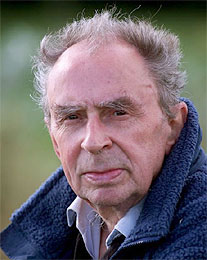|
You are on Susan Tichy's web page
George Mason
University Main
|
||
|
Ian Hamilton Finlay
1925-2006  "Evening will
come
They will sew the
blue sail"
|
||
Print Resources Finlay's two early books of poems are The Dancers Inherit the Party, 1960, reprinted 1962 & 1969, and Glasgow Beasts, An a Burd, 1961, reprinted several times up to 1965. Glasgow Beasts, denounced by Hugh MacDiarmid, was an important forerunner to Tom Leonard's Glasgow vernacular poems. A small selection of lyric poems published over forty years has recently been collected in The Blue Sail, edited by Thomas A. Clark (Glasgow: Wax 366, 2002). The
indispensible introduction to Finlay is Yves Abrioux's Ian Hamilton
Finlay: A Visual Primer. The revised second edition (1992,
318pp,
oversized) was published in Britain by Reaktion Press & in the US
by MIT Press. Includes essays by Abrioux and by Stephen Bann, a
chronology & a bibliography of Finlay's works, over 200 images, and
some of the early poems. For
the garden itself, nothing compares to a visit. In the meantime,
content yourself with Jessie Sheeler's Little Sparta: The
Garden of Ian Hamilton
Finlay (London: Frances
Lincoln Ltd, 2003). Sheeler's text runs
alongside a stunning collection of photographs by Andrew Lawson. Commentary
on Finlay can be fugitive, much having been published in exhibit
catalogs or scattered across many disciplines, in journals devoted to
art, architecture, gardening, and, more rarely, literature. Wood
Notes Wild: Essays on the Poetry and Art of Ian Hamilton Finlay,
edited
by Alec Finlay
(Edinburgh: Polygon, 1995) includes excellent
introductions to Finlay by Sue Innes, Stephen Bann, Edwin Morgan, and
others, as well as commentary on individual works, exhibits, or phases
of work. In all, more than 25 essays, poems and comments are collected
here, with about 20 photographs and images.
Another
source of biographical information, appraisals, and reminiscences is a
special double issue of the Scottish literary journal, Chapman
(78-9), devoted to Finlay. Highlights from this collection
include
extracts from Finlay's letters to the Austrian poet Ernst Jandl, Jenny
Penberthy's "A Posse of Two: Lorine Niedecker and Ian Hamilton Finlay,"
and an essay by Alec Finlay linking his father's work to that of Emily
Dickinson and Susan Howe. Poiesis:
Aspects of Contemporary Poetic
Activity, edited
by
Graeme Murray (Edinburgh: The Fruitmarket Gallery, 1992), includes
Finlay in two essays: Thomas A. Clark's "Poetry and the Space Beyond,"
and Francis Edeline's "Flowers and Fragments: On Ian Hamilton Finlay
and Mary Ellen Solt," (translated by Ken Cockburn), both of which place
Finlay, and poetry itself, in a zone of formal play that defies genre. Stephen
Scobie's Earthquakes and Explorations:
Language and Painting from
Cubism to Concrete Poetry (University of Toronto Press, 1997)
begins with the Cubists' use of language and the gender narratives of
early Modernist painting, then moves on via Apollinaire, Kahnweiler's
history of Cubism, semiotics, Gertrude Stein, and Delauny to Gadji Beri
Bimba and Ian Hamilton Finlay. Finlay
is the argument's destination, and the book pivots, finally, on
Finlay's relationships
with Juan Gris and with the iconography of the French Revolution. A
draft
of the last chapter, "Models of Order," is included in Wood Notes
Wild.
|